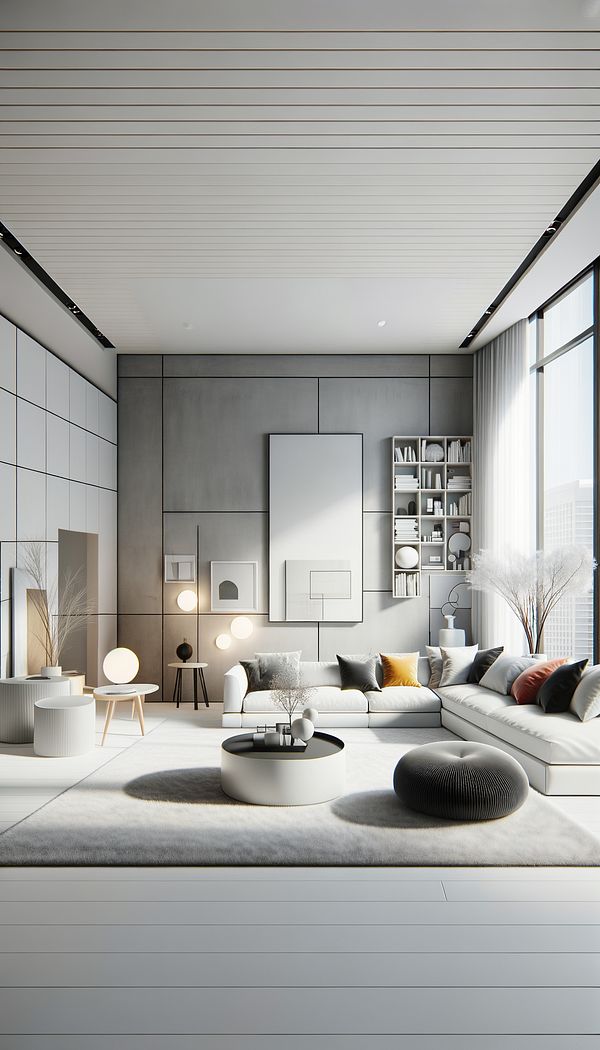What is Modern?
Modern is an interior design style that emphasizes clean lines, minimalism, and the use of new materials.
Description
Modern interior design is characterized by its emphasis on simplicity, functionality, and the use of materials such as metal, glass, and steel. This style emerged in the first half of the 20th century and was influenced by the modern art movements of the time, including Cubism, Futurism, and Constructivism. Modern design seeks to break away from the traditional, ornate styles of the past, instead aiming for a look that is sleek, uncluttered, and focused on the present and future.
The aesthetic of modern design is often defined by its clean lines and a neutral color palette, with splashes of bold color used sparingly as accents. Furniture and decor are typically minimal and functional, with geometric shapes and asymmetry playing a key role in the overall look. Modern spaces also prioritize natural light and open spaces, which helps to create a sense of airiness and spaciousness. Additionally, modern interior design frequently incorporates technology and innovative materials, both as functional components and decorative elements, to enhance the living experience.
Despite its roots in the early 20th century, modern design continues to evolve and remains influential today. It is often juxtaposed or blended with other design styles, such as Mid Century Modern or Contemporary, to create unique and personalized spaces. Understanding the principles of modern design can provide a solid foundation for exploring other interior design styles and elements.
Usage
Modern interior design is widely applied in residential homes, office spaces, and public buildings, showcasing versatility across different environments. In homes, it often results in open-plan living spaces with sleek kitchen designs, minimal bedroom setups, and living rooms with statement pieces that embody the modern aesthetic. In offices, the modern style promotes productivity and creativity through clutter-free environments and the use of ergonomic furniture. Public buildings, such as museums and libraries, leverage modern design to emphasize the architectural features of the space and to create engaging environments for visitors.
FAQs
-
How does modern interior design differ from contemporary design?
Modern interior design specifically refers to a style originating in the early 20th century, characterized by minimalism and the use of new materials. Contemporary design, on the other hand, is more fluid and represents the design trends of the current moment, often incorporating elements from multiple styles, including modern.
-
Can modern interior design be warm and inviting?
Yes, despite its reputation for minimalism and clean lines, modern design can be warm and inviting through the use of textured materials, natural elements like wood and stone, and the strategic use of color and lighting to create a cozy atmosphere.
-
Is modern interior design suitable for small spaces?
Absolutely. Modern design's emphasis on simplicity, functionality, and uncluttered spaces makes it particularly well-suited for small spaces. Furniture with clean lines and multi-functional design helps maximize the available space, while the minimal decor helps prevent the area from feeling overcrowded.
Practical Application
Incorporating modern design elements into your space begins with decluttering and focusing on the essentials. Opt for furniture with simple, geometric shapes and pieces that serve multiple purposes to maintain functionality without sacrificing style. Utilize a neutral color palette as the foundation for your space, introducing bold colors and textures sparingly to add interest and depth. Don’t forget to maximize natural light wherever possible, as it is a key component of the modern aesthetic.
-
Design Styles478 articles
-
Furniture Types599 articles
-
Lighting111 articles
-
Decorating Principles & Elements330 articles
-
Materials & Textiles360 articles
-
LinoleumLinoleum is a durable, eco-friendly floor covering made from natural materials.
-
Carver ChairA Carver Chair is a type of dining or armchair originating from the American colonies.
-
FutonA futon is a multifunctional piece of furniture that can serve as both a sofa and a bed.
-
Tailored UpholsteryTailored upholstery refers to furniture coverings that are custom-fitted and meticulously crafted for a neat, polished appearance.
-
BolsterA bolster is a long, narrow pillow or cushion filled with cotton, down, or fiber.
